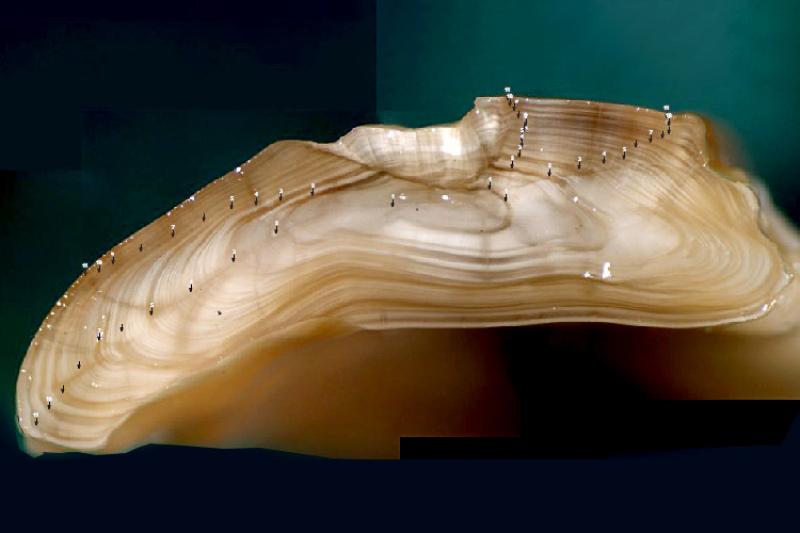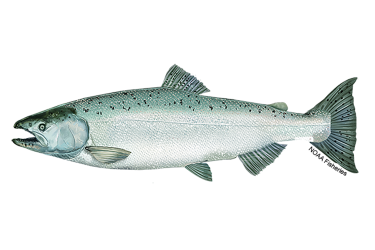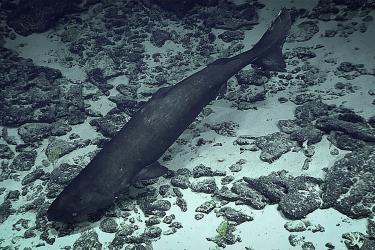Knowing how long fish live and the number of different age groups in a fish population is essential to sustainably manage Alaska’s valuable fisheries. NOAA Fisheries scientists are evaluating the use of machine-based technology—Fourier Transform-Near Infrared Spectroscopy (FT-NIRS) of otoliths—to determine fish age. Initial results on Bering Sea walleye pollock otoliths suggest with this technology NOAA Fisheries will be able to determine the age of fish more quickly and cost-effectively. Efficiency is likely to vary by species. However, for pollock preliminary estimates of efficiency could improve by 600 percent to 800 percent.
“This could transform, even revolutionize, the way we collect age data,” says Dr. Thomas Helser of the Alaska Fisheries Science Center Age and Growth Program, who is spearheading the effort. “FT-NIRS analysis is rapid and repeatable, and our preliminary analysis for eastern Bering Sea walleye pollock is highly promising.”

Age data are critical for understanding population dynamics of commercially fished species and providing management advice. Assessing populations of the Nation’s biggest fisheries is complex and requires a lot of age data.
Conventional ageing methods estimate the age of each fish by visually counting annual growth rings on its otoliths, or ear bones, under a microscope. Handling time per otolith is 3–5 minutes, plus additional time for quality control readings. With over 60,000 age requests coming in each year to NOAA’s Alaska Fisheries Science Center Age and Growth Program, this means a big investment in time, effort, and money.
"The demand for fish ageing has increased steadily but production capacity has not. With conventional methods and limited budgets, there is no way to keep up,” says Helser. “We are looking to new technology to bridge the gap."
An Age Spectrum
FT-NIRS first gained prominence in the pharmaceutical, chemical, and agricultural industries as an efficient and accurate way to measure chemical formulations for product quality and in-process monitoring of factory operations. For example, in the dairy industry, FT-NIR is used to determine the strictly regulated butterfat content of milk and other dairy products.
We are working on understanding the exact molecular constituents in otoliths that give the relationship between spectral data measured by FT-NIR and fish age. However, based on the most informative O-H, N-H and C-H regions in the near-infrared wavelength range we believe it is the organic content, including proteins, in otoliths that determine the age of fish,” Helser explains. “As a fish grows, its otoliths accrete layers of calcium carbonate, including a protein matrix within. The otoliths of a 1-year-old pollock will have less protein than those of a 10-year-old. If we can measure the difference with FT-NIRS, we will have an efficient method to age large numbers of fish.”
Helser notes that scientists in Australia began exploring the use of FT-NIRS technology to age fish about three years ago. “We are not the first to try this technology, but so far it has been in the exploratory phase. If we are able to develop it for use on a large scale, we will be the first to use FT-NIRS to age fish for stock assessments.”
Helser’s team is now working with scientists at Bruker Optics, the instrumentation's manufacturer, to perfect it for ageing large numbers of fish.
Using FT-NIR technology, light from a special near-infrared source is focused on the otolith, which absorbs some of this light at characteristic wavelengths or frequencies. The amount of light that is absorbed is measured and recorded by an instrument known as a spectrometer. This record of the light absorbance by the otolith is called a near-infrared spectrum. The process takes about 30–50 seconds per otolith—more than 10 times faster than traditional methods.
“Once spectral data on a number of samples is collected, it is correlated (using special statistical software) with recorded visual estimate of age to create models for age predictions,” explains Helser. “Matches for pollock calibration models so far have been on the order of 92 percent to 95 percent.” The calibration model is then validated with unobserved spectra from another set of otoliths to evaluate the robustness of the predictions.

The amount of light absorbed by walleye pollock otoliths of different ages at each specific frequency (wavenumber) across the NIR spectral range.
Future Ages
Helser points out that there is still a lot to learn about how organic constituents in otoliths relate to the measurement of age in fish. “We are not sure how protein gets incorporated in otoliths, so we don’t know if it varies by location, or prey type, or climate conditions. Do we need different calibrations for different locations and years? We need to nail that down.”
But once the method is fine-tuned, increased efficiency and reduced costs are only the beginning of the potential benefits of using NIR technology in fisheries research and management.
“We haven’t even begun to explore all the fisheries applications of the technology,” says Helser. “Can we differentiate species? Is it sensitive enough to measure age at monthly or weekly intervals in larval or juvenile fish, and determine actual birth dates? We might use it to look at effects of climate on growth. Moreover, we have begun to explore this technology to the rapid interrogation of other biological structures, such as female ovary tissue for maturity status and fecundity, and predator stomach contents for diet analysis. We envision the use of FT-NIR spectroscopy for the rapid assessment of fish biological structures, either in the laboratory or ship-board research surveys, which could be transformative for providing a key data source for stock assessments and ultimately management advice. And with the machine doing the mundane stuff, people will have scope to do more interesting projects. We’re excited to be realizing something that may transform our field of work.”






